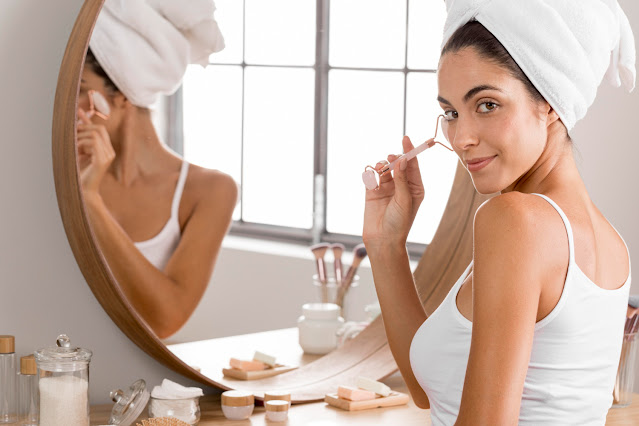
Skin Care Basics
I. Understanding Your Skin Type
The first step in creating an effective skin care routine is understanding your skin type. Your skin type can influence how your skin reacts to different products and environmental factors. Here are the primary skin types:
1. Normal Skin: Balanced skin that is neither too oily nor too dry. It has a smooth texture, small pores, and a healthy glow.
2. Dry Skin: Characterized by a lack of moisture, dry skin often feels tight, rough, and may appear flaky. It can be prone to irritation and fine lines.
3. Oily Skin: This type produces excess sebum, leading to a shiny appearance, larger pores, and a propensity for acne and blackheads.
4. Combination Skin: A mix of oily and dry areas, typically with an oily T-zone (forehead, nose, and chin) and dry cheeks.
5. Sensitive Skin: Easily irritated by products or environmental factors, sensitive skin may exhibit redness, itching, or burning sensations.
Knowing your skin type will help you choose products that cater to your specific needs and avoid those that may exacerbate issues.
II. Building a Basic Skin Care Routine
A basic skin care routine involves three main steps: cleansing, moisturizing, and protecting. Additional steps, like toning and treating specific concerns, can be added as needed.
1. Cleansing
Cleansing is the foundation of any skin care routine. It removes dirt, oil, makeup, and impurities that can clog pores and cause breakouts.
- Choose the Right Cleanser: Select a gentle cleanser that matches your skin type. For example, if you have dry skin, opt for a hydrating cleanser. If you have oily skin, a foaming or gel cleanser might be more appropriate.
- How to Cleanse: Use lukewarm water and gently massage the cleanser into your skin using circular motions. Rinse thoroughly and pat dry with a clean towel. Avoid using hot water, as it can strip your skin of its natural oils.
2. Moisturizing
Moisturizing helps maintain your skin's hydration levels and strengthens the skin barrier.
- Types of Moisturizers: There are various types of moisturizers, including creams, lotions, gels, and oils. Creams are thicker and more suitable for dry skin, while gels and lotions are lighter and better for oily skin.
- Application: Apply moisturizer to damp skin to lock in moisture. Use gentle upward strokes to avoid tugging at the skin.
3. Protecting
Sun protection is crucial for preventing skin damage, premature aging, and reducing the risk of skin cancer.
- Sunscreen: Use a broad-spectrum sunscreen with an SPF of at least 30. Apply it generously to all exposed skin, even on cloudy days and in winter.
- Daily Use: Incorporate sunscreen into your daily routine, regardless of whether you're spending the day outdoors. Reapply every two hours when exposed to the sun.
4. Toning (Optional)
Toners can provide additional benefits, such as balancing the skin's pH, removing residual impurities, and preparing the skin for other products.
- Choosing a Toner: Look for alcohol-free toners to avoid drying out your skin. Ingredients like witch hazel, rose water, and hyaluronic acid can offer specific benefits depending on your skin type.
- How to Use: Apply toner to a cotton pad and gently swipe it across your face after cleansing.
5. Treating (Optional)
Treatments target specific skin concerns like acne, hyperpigmentation, or aging. These can include serums, spot treatments, and exfoliants.
- Serums: Packed with active ingredients, serums can address a variety of issues, from brightening and hydrating to anti-aging. Apply them before moisturizing.
- Exfoliation: Regular exfoliation helps remove dead skin cells, promoting a brighter complexion and smoother texture. Use a chemical exfoliant (like AHAs or BHAs) or a gentle scrub 1-2 times a week.
III. Addressing Common Skin Concerns
1. Acne
Acne is a common skin condition that can affect people of all ages. It can be caused by excess oil production, clogged pores, bacteria, and hormonal changes.
- Prevention: Keep your skin clean, avoid touching your face, and use non-comedogenic products.
- Treatment: Over-the-counter products with benzoyl peroxide or salicylic acid can be effective. For severe cases, consult a dermatologist for prescription treatments.
2. Hyperpigmentation
Hyperpigmentation is characterized by dark spots or patches on the skin, often caused by sun exposure, inflammation, or hormonal changes.
- Prevention: Regular use of sunscreen can prevent further pigmentation.
- Treatment: Ingredients like vitamin C, niacinamide, and retinoids can help lighten dark spots. Professional treatments, such as chemical peels and laser therapy, may also be effective.
3. Aging
As we age, our skin naturally loses elasticity and moisture, leading to fine lines, wrinkles, and sagging.
- Prevention: Protect your skin from the sun, maintain a healthy diet, and avoid smoking.
- Treatment: Use products with anti-aging ingredients like retinoids, peptides, and antioxidants. Hydrating and firming treatments can also improve the skin's appearance.
4. Dryness
Dry skin can be uncomfortable and prone to cracking and irritation.
- Prevention: Avoid hot showers and harsh soaps. Use a humidifier in dry environments.
- Treatment: Hydrate your skin with rich, emollient moisturizers. Look for ingredients like hyaluronic acid, glycerin, and ceramides.
5. Sensitivity
Sensitive skin reacts easily to products and environmental factors, often resulting in redness, itching, or burning.
- Prevention: Identify and avoid triggers, such as certain ingredients or environmental stressors.
- Treatment: Use gentle, fragrance-free products. Ingredients like aloe vera, chamomile, and oatmeal can soothe sensitive skin.
IV. Lifestyle Tips for Healthy Skin
1. Stay Hydrated: Drinking plenty of water helps maintain your skin's moisture levels and supports overall health.
2. Eat a Balanced Diet: A diet rich in fruits, vegetables, lean proteins, and healthy fats provides the nutrients your skin needs to stay healthy. Antioxidants, like vitamins C and E, can help protect your skin from damage.
3. Get Enough Sleep: Adequate sleep allows your skin to repair and regenerate. Aim for 7-9 hours of quality sleep each night.
4. Manage Stress: Chronic stress can negatively affect your skin, leading to breakouts and other issues. Practice stress management techniques such as meditation, yoga, or deep breathing exercises.
5. Avoid Smoking and Excessive Alcohol: Smoking and excessive alcohol consumption can accelerate skin aging and lead to various skin problems. Quitting smoking and moderating alcohol intake can significantly improve your skin's appearance and health.

Conclusion
Taking care of your skin doesn't have to be complicated. By understanding your skin type, building a basic routine, and addressing specific concerns, you can maintain healthy, radiant skin. Remember, consistency is key, and it's important to give products time to work. Alongside a balanced diet, adequate hydration, and a healthy lifestyle, these skin care basics will help you achieve and maintain beautiful skin.
FAQ
Ques 1: How do I determine my skin type?
Ans: To determine your skin type, start with a clean face. Wash your face with a gentle cleanser and pat it dry. After an hour, observe how your skin feels:
a) Normal Skin: Feels balanced and comfortable.
b) Dry Skin: Feels tight and may appear flaky.
c) Oily Skin: Looks shiny, especially in the T-zone.
d) Combination Skin: Oily in the T-zone but dry or normal on the cheeks.
e|) Sensitive Skin: Feels irritated or shows redness.
Ques 2: What is the basic skin care routine everyone should follow?
Ans: A basic skin care routine includes:
a) Cleansing: Use a gentle cleanser suitable for your skin type to remove dirt and impurities.
b) Moisturizing: Apply a moisturizer to keep your skin hydrated.
c) Protecting: Use a broad-spectrum sunscreen with at least SPF 30 daily to protect your skin from UV damage.
Optional steps include toning after cleansing and treating specific concerns with serums or spot treatments before moisturizing.
Ques 3: How often should I exfoliate my skin?
Ans: Exfoliation should be done 1-2 times a week, depending on your skin type and the exfoliant used. Over-exfoliating can irritate and damage your skin. If you have sensitive skin, opt for a gentle exfoliant and use it less frequently.
Ques 4: Can I use the same moisturizer for day and night?
Ans: You can use the same moisturizer for both day and night, but for optimal results, consider a day moisturizer with SPF for sun protection and a night moisturizer that is richer and more hydrating. Night creams often contain ingredients like peptides and retinoids that help repair the skin while you sleep.
Ques 5: What ingredients should I look for in skin care products?
Ans: The ingredients you need depend on your skin concerns:
a) Dry Skin: Hyaluronic acid, glycerin, ceramides.
b) Oily/Acne-Prone Skin: Salicylic acid, benzoyl peroxide, niacinamide.
c) Aging Skin: Retinoids, peptides, antioxidants like vitamin C and E.
d) Sensitive Skin: Aloe vera, chamomile, oatmeal, and fragrance-free formulas.
Choosing the right ingredients helps address specific skin needs effectively.







Do Leave Your Comment